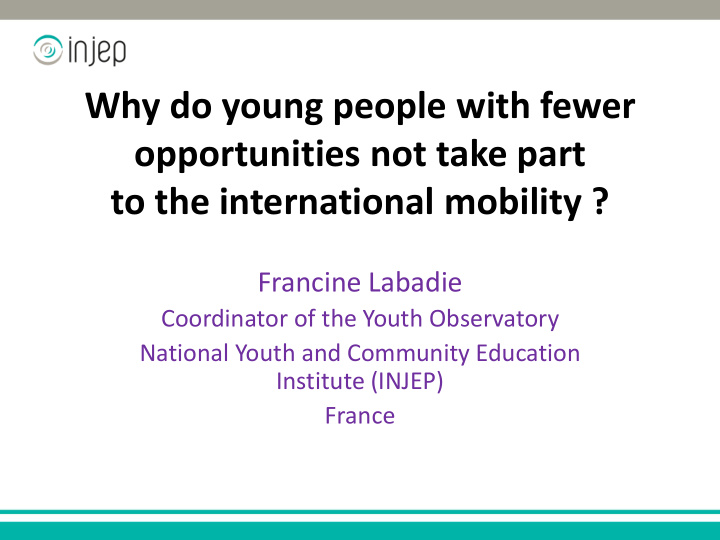



Why do young people with fewer opportunities not take part to the international mobility ? Francine Labadie Coordinator of the Youth Observatory National Youth and Community Education Institute (INJEP) France
Introduction • Encouraging the access of YPFO to international mobility within a non-formal framework = why ? A matter of fairness A capacitating experience • But a goal far from being reached … • How to interpret these results ?
The qualitative study - Launched in September 2015 until March 2016 in order to highlight and comprehend the obstacles that restrict the access of YPFO to the YiA programme. - Carried out in three regions of France (Alsace, Île-de-France and Provence-Alpes-Côte d'Azur) and in two stages
The theoritical framework • Main hypothesis = limited take-up could result from a combination of barriers rooted in the practices and representations of youth professionals and in the characteristics and life paths of young people. • Within the theoretical framework developed by P. Warin (2010) on the " non-take-up to rights and services ", as concerning " every person not benefitting from a public offer of rights and services which he or she can claim “ .
A brief overview of the French context • Role of the “ local missions ” : local missions were created to enable young people with integration difficulties "to build and complete a path to social and professional integration ” . • An essential upstream link in access to international mobility. • But with the institutionnalisation of the local missions, the issue of professional integration has largely taken precedence over that of social integration
Key survey findings
Going abroad : decisive and non decisive factors A decisive factor : The local missions and youth structures play a central role of information and orientation towards international mobility. A semi-decisive factor : Depending on the cases, the family can encourage or prevent the international mobility. A non-decisive factor : Friends don’t influence the decision of going abroad.
When institutions limit mobility opportunities for YPFO 1. Representations and beliefs on international mobility Not all social and professional integration professionals are convinced that an experience abroad is useful for young people with fewer opportunities = a source of potential inequality among young people. Two main approaches to international mobility : - Time out and “ socialisation mobility” - International mobility as a way to develop the employability
When institutions limit mobility opportunities for YPFO 2. The project as a social norm The ability to participate in a project is often a prerequisite to an experience abroad But all young people are not equal regarding the project norm
When institutions limit mobility opportunities for YPFO 3. Institutional configurations and selection processes leading to the non-proposal of international mobility Certain structures apply eligibility criteria - imposed by institutional organisations or internal selection processes- , ending in cases of "non-take-up" through the absence of a proposal. The importance of avoiding potential failure or risks linked to the behaviour of vulnerable young people
The challenge of « counselling » The needs of YPFO to be counselled Two conceptions of counselling in tension : • Guidance • Escort
Final remarks To place this type of mobility in a true perspective of "capacitating" public policy, which would enable the young to achieve their aspirations and improve their private and professional situations, it is important to "widen access to the existing rights and public proposals", "to take more account of life paths", and as regards the institutions, "to draw on the network of players closest to the young" upstream and downstream, in particular to "sustain and equip local support networks for vulnerable youth" .
Recommend
More recommend